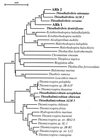Microbial thiocyanate utilization under highly alkaline conditions
- PMID: 11157213
- PMCID: PMC92617
- DOI: 10.1128/AEM.67.2.528-538.2001
Microbial thiocyanate utilization under highly alkaline conditions
Abstract
Three kinds of alkaliphilic bacteria able to utilize thiocyanate (CNS-) at pH 10 were found in highly alkaline soda lake sediments and soda soils. The first group included obligate heterotrophs that utilized thiocyanate as a nitrogen source while growing at pH 10 with acetate as carbon and energy sources. Most of the heterotrophic strains were able to oxidize sulfide and thiosulfate to tetrathionate. The second group included obligately autotrophic sulfur-oxidizing alkaliphiles which utilized thiocyanate nitrogen during growth with thiosulfate as the energy source. Genetic analysis demonstrated that both the heterotrophic and autotrophic alkaliphiles that utilized thiocyanate as a nitrogen source were related to the previously described sulfur-oxidizing alkaliphiles belonging to the gamma subdivision of the division Proteobacteria (the Halomonas group for the heterotrophs and the genus Thioalkalivibrio for autotrophs). The third group included obligately autotrophic sulfur-oxidizing alkaliphilic bacteria able to utilize thiocyanate as a sole source of energy. These bacteria could be enriched on mineral medium with thiocyanate at pH 10. Growth with thiocyanate was usually much slower than growth with thiosulfate, although the biomass yield on thiocyanate was higher. Of the four strains isolated, the three vibrio-shaped strains were genetically closely related to the previously described sulfur-oxidizing alkaliphiles belonging to the genus Thioalkalivibrio. The rod-shaped isolate differed from the other isolates by its ability to accumulate large amounts of elemental sulfur inside its cells and by its ability to oxidize carbon disulfide. Despite its low DNA homology with and substantial phenotypic differences from the vibrio-shaped strains, this isolate also belonged to the genus Thioalkalivibrio according to a phylogenetic analysis. The heterotrophic and autotrophic alkaliphiles that grew with thiocyanate as an N source possessed a relatively high level of cyanase activity which converted cyanate (CNO-) to ammonia and CO2. On the other hand, cyanase activity either was absent or was present at very low levels in the autotrophic strains grown on thiocyanate as the sole energy and N source. As a result, large amounts of cyanate were found to accumulate in the media during utilization of thiocyanate at pH 10 in batch and thiocyanate-limited continuous cultures. This is a first direct proof of a "cyanate pathway" in pure cultures of thiocyanate-degrading bacteria. Since it is relatively stable under alkaline conditions, cyanate is likely to play a role as an N buffer that keeps the alkaliphilic bacteria safe from inhibition by free ammonia, which otherwise would reach toxic levels during dissimilatory degradation of thiocyanate.
Figures

Similar articles
-
Thioalkalivibrio thiocyanoxidans sp. nov. and Thioalkalivibrio paradoxus sp. nov., novel alkaliphilic, obligately autotrophic, sulfur-oxidizing bacteria capable of growth on thiocyanate, from soda lakes.Int J Syst Evol Microbiol. 2002 Mar;52(Pt 2):657-664. doi: 10.1099/00207713-52-2-657. Int J Syst Evol Microbiol. 2002. PMID: 11931180
-
Thioalkalimicrobium aerophilum gen. nov., sp. nov. and Thioalkalimicrobium sibericum sp. nov., and Thioalkalivibrio versutus gen. nov., sp. nov., Thioalkalivibrio nitratis sp.nov., novel and Thioalkalivibrio denitrificancs sp. nov., novel obligately alkaliphilic and obligately chemolithoautotrophic sulfur-oxidizing bacteria from soda lakes.Int J Syst Evol Microbiol. 2001 Mar;51(Pt 2):565-580. doi: 10.1099/00207713-51-2-565. Int J Syst Evol Microbiol. 2001. PMID: 11321103
-
Anaerobic growth of the haloalkaliphilic denitrifying sulfur-oxidizing bacterium Thialkalivibrio thiocyanodenitrificans sp. nov. with thiocyanate.Microbiology (Reading). 2004 Jul;150(Pt 7):2435-2442. doi: 10.1099/mic.0.27015-0. Microbiology (Reading). 2004. PMID: 15256585
-
[Oxidation of inorganic sulfur compounds by obligatory organotrophic bacteria].Mikrobiologiia. 2003 Nov-Dec;72(6):725-39. Mikrobiologiia. 2003. PMID: 14768537 Review. Russian.
-
Chemolithotrophic haloalkaliphiles from soda lakes.FEMS Microbiol Ecol. 2005 May 1;52(3):287-95. doi: 10.1016/j.femsec.2005.02.012. FEMS Microbiol Ecol. 2005. PMID: 16329914 Review.
Cited by
-
Development of a mixed microbial culture for thiocyanate and metal cyanide degradation.3 Biotech. 2017 Jul;7(3):191. doi: 10.1007/s13205-017-0814-6. Epub 2017 Jun 29. 3 Biotech. 2017. PMID: 28664381 Free PMC article.
-
Unusual Cytochrome c552 from Thioalkalivibrio paradoxus: Solution NMR Structure and Interaction with Thiocyanate Dehydrogenase.Int J Mol Sci. 2022 Sep 1;23(17):9969. doi: 10.3390/ijms23179969. Int J Mol Sci. 2022. PMID: 36077365 Free PMC article.
-
Complete genome sequence of "Thioalkalivibrio sulfidophilus" HL-EbGr7.Stand Genomic Sci. 2011 Feb 14;4(1):23-35. doi: 10.4056/sigs.1483693. Stand Genomic Sci. 2011. PMID: 21475584 Free PMC article.
-
Exploring anaerobic environments for cyanide and cyano-derivatives microbial degradation.Appl Microbiol Biotechnol. 2018 Feb;102(3):1067-1074. doi: 10.1007/s00253-017-8678-6. Epub 2017 Dec 5. Appl Microbiol Biotechnol. 2018. PMID: 29209795 Free PMC article. Review.
-
Depth distribution of microbial diversity in Mono Lake, a meromictic soda lake in California.Appl Environ Microbiol. 2003 Feb;69(2):1030-42. doi: 10.1128/AEM.69.2.1030-1042.2003. Appl Environ Microbiol. 2003. PMID: 12571026 Free PMC article.
References
-
- Anderson P M. Purification and properties of the inducible enzyme cyanase. Biochemistry. 1980;19:2883–2887. - PubMed
-
- Betts P M, Rinder D F, Fleeker J R. Thiocyanate utilization by an Arthrobacter. Can J Microbiol. 1979;25:1277–1282. - PubMed
-
- Boucabeille C, Bories A, Ollivier P. Degradation of thiocyanate by a bacterial coculture. Biotechnol Lett. 1994;16:425–430.
-
- Buczowska Z, Jarnuszkiewicz I. The biochemical activity of mixed bacterial cultures acclimated to thiocyanate. Bull Inst Mer Med Gdansk. 1968;19:201–210. - PubMed
-
- Catchpole J R, Cooper R L. The biological treatment of carbonization wastes. New advances in the biochemical oxidation of liquid wastes. Water Res. 1972;6:1459–1474.
Publication types
MeSH terms
Substances
Associated data
- Actions
- Actions
LinkOut - more resources
Full Text Sources
Molecular Biology Databases
Research Materials

